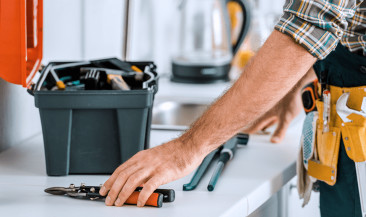
Latchel, a tech startup in Tacoma Washington that aids property managers to streamline their maintenance operations is called Latchel. Their service has a wide array of features including a proprietary emergency maintenance technology that helps property managers minimize the damage done by an emergency. This technology can help reduce insurance costs. They also provide an innovative, user-friendly maintenance management platform. They currently support 27,500 units in 50 US cities.
The company launched their full-service platform in March. This portal and app allow property managers to manage all aspects of maintenance. You also get a variety of benefits like an emergency maintenance, concierge, insurance, and contactless repairs. The services allow landlords to improve the experience of their residents and increase their profitability. Vendor Pay recently included fintech, which allows them the ability to invoice service providers.
One of their most impressive feats is their proprietary emergency maintenance technology. Its ability minimize damage from an emergency is what sets them apart. An important but not insignificant part of their service is the emergency phone number that is available to tenants seven days a semaine, 24 hours a year. If the problem is not too large for the service professionals to handle, they will dispatch them to your location.

Their video-based troubleshooting technology is another feature of the system. The system is capable of saving up to 30% from emergency maintenance requests. This eliminates the need to have a technician come to your home. With the help of this technology, the average landlord can save around $180 per unit per year.
Latchel is also a great example of a cloud-based service that helps property managers provide a better experience to their residents. You can reach them by text and phone, for example, through their mobile app. A resident can request maintenance services and book them quickly. It can handle emergency maintenance such as evictions.
Their product also includes data-driven expert analysis by their CB Insights Intelligence Unit. They use algorithms to make sense of data and help property managers decide the best way to manage any maintenance problem. Latchel collects residents' feedback at the end.
Overall, Latchel is an exciting, innovative company that has a lot to offer. They have a solid platform and are quickly becoming a top provider of innovative solutions for property management. Their proprietary technology, their concierge services, and emergency response are all part of a revolution in the world residential rental properties.

Property managers who want to make their customers happy and improve their bottom line will love Latchel. Your tenants will appreciate your assistance and you'll be able to provide them with a better living situation.
FAQ
What's the typical time taken to complete a DIY project like this?
A DIY project can take anywhere from 2 to 4 hours. The difficulty and complexity of the project will affect how long it takes.
What qualifications are necessary to be a handyman
Being a handyman requires patience. Also, experience with working with electrical systems, carpentry skills and plumbing knowledge is essential.
It is likely that you will find many jobs for people who have the right qualifications. But if you don’t, you may not be qualified.
You may want to look into getting training at a school that offers these courses.
What is the hourly rate for a handyman?
A handyman can charge between $50-$75 an hour. They've been doing it for years. Their average time on any job is approximately 10 hours. They don't need to advertise; they are well known in the neighborhood.
They have a tendency to be specialized and develop customer relationships over time.
They are quick, reliable, and affordable. This is the key difference between them and other contractors.
Most people know at least 2-3 of these guys they trust enough to call when they need help.
Some people have their own business.
Which is simpler: Contracting or being a handyman.
Because you only need tools and yourself, being a handyman is more time-consuming than contracting. While contractors often rely on subcontractors, handymen must be able and willing to manage their own work schedules.
What are the most common handyman repair tasks?
Handymen can repair damaged roofs or windows, doors and gutters. When it comes to building or home improvement projects that cannot be performed by DIY homeowners, handymen can help with carpentry, plumbing, painting, drywall installation, landscaping, concrete work, fence construction, decking, tiling, and more.
What can a handyman do to fix my leaky faucets
A handyman can probably handle minor repairs but will not have the training required to perform major projects, such as rewiring a house or installing custom cabinetry. A handyman can do minor home improvements, but there are no limitations to his abilities.
Is it better to pay a handyman on an hourly basis or per-project basis?
Personal preference will dictate the final price. Some people prefer paying by the hour to know exactly how much their handyman charges. Some prefer to pay for each project, even though they may be doing multiple jobs at once. Either way works fine.
Statistics
- An estimate was that in 2003, the market for home maintenance and repair spending was up 14% 2001 to 2003. (en.wikipedia.org)
- “Once the pandemic hit, that number fell to about 20%.” (inquirer.com)
- “Before the pandemic, 40% of people asked how we could estimate a job when we weren't there,” Rose recalled. (inquirer.com)
- A franchise was approximately $110,000 with a franchise fee of $14,900, according to a spokesperson for a national handyman franchise. (en.wikipedia.org)
- Mila keeps a commission of 20% for each completed service performed by Friends and charges various service fees regarding work done by Pros. (appjobs.com)
External Links
How To
How to replace a damaged tile
Step 1: Take away the old tiles.
Take out the tiles and place them on a new flooring surface. These tiles will be useful later on, so you'll need to keep them intact. If they're damaged or missing pieces, note which ones they were so you don't run into problems finding replacements.
Step 2 -- Choose New Tiles
Check out these options for tile replacement.
-
You can find a tile replacement that is similar to the one you have just removed.
-
To find the matching piece, use the measurements that you took while removing the tile. This makes it easier to get the right size without having to measure again.
-
Consider looking for colors, patterns, textures and sizes in a variety of shapes and colors.
-
Consider what grout you'd like to use (if any). Some people prefer to use a single color, while others love mixing it up.
-
You should ensure that the tile you choose is resistant to moisture.
-
Also, think about where you want to place your new tile. This will help you save time and money.
-
Once you've found the tile that suits your needs, you can place your order online.
Step 3 – Install the new tiles.
For your new tiles, use the same method that you used to install them. It's important to align them correctly in order for them to fit together.
Step 4 - Clean Up
Before putting down the final layer of protective material, clean up all the debris from the floor.
This will prevent dirt and dust from settling into the cracks between the tiles that could cause mold.
Step 5: Sand down the Floor
After everything has been cleaned, sand it down to remove any remaining particles from the previous steps.
Step 6 - Close the door
Apply the protective coatings once the floor is smooth. You should wait until this stage as wet paint can stain new tiles.
To help prevent stains, you could always use a product called 'damp-anddry' on your floors.
However, it will not cover all possible problems that may arise after you have installed your tiles. An anti-slip coating can be added to the protective layer for children who are often running around.
Remember to let the protective sealer remain on for several additional weeks before you move into your home.